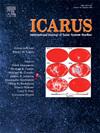Accretion of Uranus and Neptune: Confronting different giant impact scenarios
IF 2.5
2区 物理与天体物理
Q2 ASTRONOMY & ASTROPHYSICS
引用次数: 0
Abstract
The origins of Uranus and Neptune are not fully understood. Their inclined rotation axes – obliquities – suggest that they experienced giant impacts during their formation histories. Simulations modeling their accretion from giant impacts among 5 Earth masses planetary embryos – with roughly unity impactors’ mass ratios – have been able to broadly match their current masses, final mass ratio, and obliquity. However, due to angular momentum conservation, planets produced in these impacts tend to rotate too fast, compared to Uranus and Neptune. One potential solution for this problem consists of invoking instead collisions of objects with large mass ratios (e.g. a proto-Uranus with 13 M and an embryo of 1 M). Smooth-particle hydrodynamics simulations show that in this scenario final planets tend to have rotation periods more consistent with those of Uranus and Neptune. Here we performed a large suite of N-body numerical simulations modeling the formation of Uranus and Neptune to compare these different dynamical views. Our simulations start with a population of protoplanets and account for the effects of type-I migration, inclination and eccentricity tidal damping. Our results show that although scenarios allowing for large impactors’ mass ratio favor slower rotating planets, the probability of occurring collisions in these specific simulations is significantly low. This is because gas tidal damping is relatively less efficient for low-mass embryos (1 M) and, consequently, such objects are mostly scattered by more massive objects (13 M) instead of colliding with them. Altogether, our results show that the probability of broadly matching the masses, mass ratio, and rotation periods of Uranus and Neptune in these two competing formation scenarios is broadly similar, within a factor of 2, with overall probabilities of the order of 0.1%–1%.
求助全文
约1分钟内获得全文
求助全文
来源期刊

Icarus
地学天文-天文与天体物理
CiteScore
6.30
自引率
18.80%
发文量
356
审稿时长
2-4 weeks
期刊介绍:
Icarus is devoted to the publication of original contributions in the field of Solar System studies. Manuscripts reporting the results of new research - observational, experimental, or theoretical - concerning the astronomy, geology, meteorology, physics, chemistry, biology, and other scientific aspects of our Solar System or extrasolar systems are welcome. The journal generally does not publish papers devoted exclusively to the Sun, the Earth, celestial mechanics, meteoritics, or astrophysics. Icarus does not publish papers that provide "improved" versions of Bode''s law, or other numerical relations, without a sound physical basis. Icarus does not publish meeting announcements or general notices. Reviews, historical papers, and manuscripts describing spacecraft instrumentation may be considered, but only with prior approval of the editor. An entire issue of the journal is occasionally devoted to a single subject, usually arising from a conference on the same topic. The language of publication is English. American or British usage is accepted, but not a mixture of these.
 求助内容:
求助内容: 应助结果提醒方式:
应助结果提醒方式:


